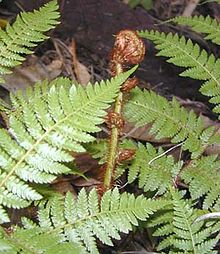Leptosporangiate fern
| Pteridopsida ~ Modern Ferns | |
|---|---|

| |
| Tree fern | |
| Scientific classification | |
| Missing taxonomy template (fix): | Pteridopsida |
| Orders | |
Leptosporangiate ferns are the largest group of living ferns. They are often considered to be the class Pteridopsida or Polypodiopsida,[1] although other classifications assign them a different rank.[2] The leptosporangiate ferns are one of the four major groups of ferns, with the others being Marattiopsida, Equisetopsida (horsetails), and Psilotopsida (whisk ferns and ophioglossoid ferns).[1]
There are approximately 9000 species of living leptosporangiate ferns, compared with about 260 for all other ferns put together.[3] Almost a third of leptosporangiate fern species are epiphytes.[3]
These ferns are called leptosporangiate because their sporangia arose from a single epidermal cell and not from a group of cells as in eusporangiate ferns. The sporangia are typically covered with a scale called the indusium, which can cover the whole sorus, but can also be strongly reduced. Many leptosporangiate ferns have an annulus around the sporangium, which ejects the spores.
Classification
Most extant fern families are leptosporangiates. Examples are: Dryopteridaceae, Cyatheaceae, Polypodiaceae, Athyriaceae, Woodsiaceae, Onocleaceae, Lomariopsidaceae and Tectariaceae.
The classification scheme proposed by Smith et al.(alternative names in brackets):
- Order Osmundales
- Family Osmundaceae
- Order Hymenophyllales
- Family Hymenophyllaceae (incl. Trichomanaceae)
- Order Gleicheniales
- Family Gleicheniaceae (incl. Dicranopteridaceae, Stromatopteridaceae)
- Family Dipteridaceae (incl. Cheiropleuriaceae)
- Family Matoniaceae
- Order Schizaeales
- Family Lygodiaceae
- Family Anemiaceae (incl. Mohriaceae)
- Family Schizaeaceae
- Order Salviniales
- Family Marsileaceae (incl. Pilulariaceae)
- Family Salviniaceae (incl. Azollaceae)
- Order Cyatheales
- Family Thyrsopteridaceae
- Family Loxsomataceae
- Family Culcitaceae
- Family Plagiogyriaceae
- Family Cibotiaceae
- Family Cyatheaceae (incl. Alsophilaceae, Hymenophyllopsidaceae)
- Family Dicksoniaceae (incl. Lophosoriaceae)
- Family Metaxyaceae
- Order Polypodiales (the Smith 2006 paper defines this order broadly; the following list also shows some of the subgroups which are sometimes considered to be separate orders)
- Family Lindsaeaceae (incl. Cystodiaceae, Lonchitidaceae)
- Family Saccolomataceae
- Family Dennstaedtiaceae (incl. Hypolepidaceae, Monachosoraceae, Pteridiaceae)
- Family Pteridaceae (incl. Acrostichaceae, Actiniopteridaceae, Adiantaceae, Anopteraceae, Antrophyaceae, Ceratopteridaceae, Cheilanthaceae, Cryptogrammaceae, Hemionitidaceae, Negripteridaceae, Parkeriaceae, Platyzomataceae, Sinopteridaceae, Taenitidaceae, Vittariaceae)

Adiantum lunulatum from Family Pteridaceae - Order Blechnales (eupolypods II in the Smith 2006 paper)
- Family Aspleniaceae
- Family Thelypteridaceae
- Family Woodsiaceae (incl. Athyriaceae, Cystopteridaceae)
- Family Blechnaceae (incl. Stenochlaenaceae)
- Family Onocleaceae
- Eupolypods I in Smith 2006
- Family Dryopteridaceae (incl. Aspidiaceae, Bolbitidaceae, Elaphoglossaceae, Hypodematiaceae, Peranemataceae)
- Family Lomariopsidaceae (incl. Nephrolepidaceae)
- Family Tectariaceae
- Family Oleandraceae
- Family Davalliaceae
- Family Polypodiaceae (incl. Drynariaceae, Grammitidaceae, Gymnogrammitidaceae, Loxogrammaceae, Platyceriaceae, Pleurisoriopsidaceae)
Discussion of Molecular Classification
There has been some challenge to the recent molecular studies, claiming that these provide a skewed view of the phylogenetic order because the studies don't take into account fossil representatives[4]. However, the molecular studies have clarified relations among families that were thought to be non-monophyletic before the advent of molecular information, which were left in their non-monophyletic ranks because there was not enough information to do otherwise[5]. The reclassification of ferns using multiple molecular studies, which have generally supported each other, is not any different from classifications of the past—it is the definition of the relations utilizing the all the information available. It does not discourage the further study and clarification of the groups, and does not mean that if further study proves the classification wrong, it will not be changed.
References
- ^ a b Smith, A. R., K. M. Pryer, et al. (2006). "A classification for extant ferns." Taxon 55(3): 705-731
- ^ Chase, Mark W. and Reveal, James L. (October 2009), A phylogenetic classification of the land plants to accompany APG III, vol. 161, Botanical Journal of the Linnean Society, pp. 122–127, doi:10.1111/j.1095-8339.2009.01002.x
{{citation}}: CS1 maint: multiple names: authors list (link) - ^ a b Schuettpelz, Eric. "Fern Phylogeny Inferred from 400 Leptosporangiate Species and Three Plastid Genes," contained in "The Evolution and Diversification of Epiphytic Ferns." Doctoral dissertation, Duke University. 2007. http://dukespace.lib.duke.edu/dspace/bitstream/10161/181/1/D_Schuettpelz_Eric_a_052007.pdf
- ^ Rothwell, G. W. and K. C. Nixon (2006). "How does the inclusion of fossil data change our conclusions about the phylogenetic history of euphyllophytes." Int. J. Plant Sci 167(3): 737-749
- ^ Kramer, K. U. (1990). Notes on the Higher Level Classification of the Recent Ferns. The Families and Genera of Vascular Plants: Pteridophytes and Gymnosperms. K. Kubitzki, K. U. Kramer and P. S. Green. New York, Springer-Verlag. 1: 49-52

